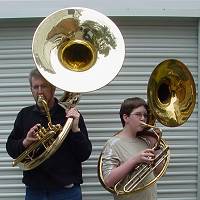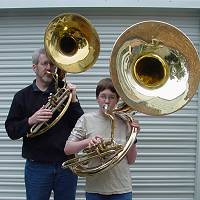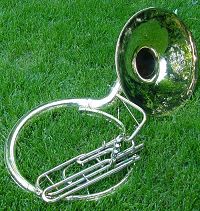Honey, I Shrunk the Sousaphone
 The
two gentlemen in the photos show how careful you have to be when washing
your sousaphone. If you leave it in the dryer too long . . .
The
two gentlemen in the photos show how careful you have to be when washing
your sousaphone. If you leave it in the dryer too long . . .
I watch the brass musical instruments pages on ebay. Every once in a
while there is something worth bidding on. So now I own six instruments.
They were all good buys at what I paid, but only one of them is "special"
in the sense that you couldn't run down to Dillon
Music and get a better one any day of the week. It's a sousaphone,
but smaller in scale than most sousaphones. I think I would have had more
of a bidding battle for it, but in the auction photo it  was
hard to picture how small it really is. I have since seen two more of
these, in Bb, on ebay; if you know of others, send me a photo and specs
and I will record yours on this page.
was
hard to picture how small it really is. I have since seen two more of
these, in Bb, on ebay; if you know of others, send me a photo and specs
and I will record yours on this page.
Both of these sousaphones are in Eb, which means that in spite of appearances the pipe if you unrolled it would be about the same length for both. (See Tubas in Eb.)
The little sousaphone has the brand name Concord Cadet engraved, but it is marked Made in Italy on the mouthpipe and is clearly the same product line as the Barcone units in David Neill's museum. Note that in tuning mine is between the two museum units: lower than the sousaphone-shaped Bb baritone, and higher than the BBb sousaphone. In age, we don't know. The serial number on mine is well below the number on the Neillins Barcone. Experts could probably estimate a date based on the "color scheme": the valve tubing is in chrome, the rest of the horn in brass.
 The
Cadet name hints that the design purpose is for school bands, where full-sized
sousaphones would have been too heavy.
The
Cadet name hints that the design purpose is for school bands, where full-sized
sousaphones would have been too heavy.
It has a bore of .59 inches, compared to the .69 bore of the larger sousaphone. See full comparison table. A typical trombone bore would be .50; full-size Bb tubas would have bores of .75 or even larger. Not only is the bore relatively narrow, but the mouthpipe accepts the shank not of a tuba mouthpiece, but of a euphonium or trombone mouthpiece. With the narrow bore and the small mouthpiece, the sound is not very tuba-like. It sounds more like a French horn or a trombone.
The alternative to the euphonium mouthpiece is the scary "Mongrel" I made -- a euphonium mouthpiece shank soldered to the cup of a tuba mouthpiece. This is an interesting mouthpiece to try on a euphonium or trombone, as well.
Tubas in Eb
Some tuba players tend to think of a tuba in Eb as a bad idea, putting it in the same class as warm beer and taxation without representation: "Unforgiveable, and the British are to blame." (Eb tubas are welcome in British brass bands.) Eb tubas are sold at a substantial discount compared to Bb tubas of the same quality.
Eb tubas have an important redeeming quality, which they share with treble clef baritone horns and euphoniums: They offer a trumpet player the chance to make an attractive noise (which no one can really do with the trumpet) without learning new fingering.
Someone who has learned to play a Bb instrument on the treble clef, can take an Eb tuba, add three sharps, and read the bass clef as though it were the treble clef.
The range of an Eb tuba overlaps a lot with that of a bass trombone, but the sound is much richer, less like an 18-wheeler's air horn. The bottom of the range is 8 semi-tones lower than the bottom of the euphonium's range and a four-valve euphonium can reach all of a three-valve Eb tuba's range.
Cleaning
The little sousaphone's lacquer was actually in quite good shape for the horn's age, but it had darkened so the apparent tint of the piece was brown or bronze. A previous owner had scratched identifying numbers in several places on the horn. Once I determined that the little sousaphone was a keeper, I made plans to clean it up. This would be the first time I would go beyond just washing a horn.
Rubbing with Brasso, I found that the metal was mostly in very nice shape, but enough rubbing to take the lacquer off would have been years. Home Depot carries a brass cleaning kit that includes lacquer removing gunk. Any paint-remover jell should work, but check the can for instructions. It makes a messy job, but the results were terrific.
The steps are:
brush gunk on with brush
wipe gunk off with paper towels
rub with Brasso on an old towel
polish with clean old all-cotton t-shirt
Last step (which I haven't taken yet) is a new coat of lacquer.
This process really helps you bond with the instrument, in all its dimensions. In fact you will come to suspect that the instrument has more than three dimensions. If you look at this side, and then at the other side, you would think you have seen all there is, but when you are polishing tens of feet of brass pipe, you can turn it over any number of times and find another swatch of tubing that hasn't been polished.
The scratched on numbers did not disappear, but they nearly did. They had been scratched into the lacquer so that the underlying metal could tarnish, making the scratched lines dark and prominent. Polishing left faint lines, but the numbers are nowhere near as obtrusive.
The table below compares the little sousaphone to other instruments in my "collection". All five instruments shown date from between 1921 and 1960. The euphonium is the oldest of the group.
| all dimensions in inches | Bb Tuba by Olds |
Eb Tuba King by H.N. White |
Eb Sousaphone King by H.N. White | Eb Sousaphone Concord Cadet by Barcone |
Bb Euphonium Holton |
| bell diameter | 16.00 | 15.00 | 26.00 | 18.44 | 10.88 |
| bore at main tuning slide | .69 | .63 | .69 | .59 | .66 |
| valve diameter | .97 | .97 | .97 | .78 | .94 |
| valve throw | .86 | .81 | .91 | .72 | .81 |
By the numbers it is clear what a small-bore instrument the little sousaphone is -- smaller in all but bell diameter than a euphonium.